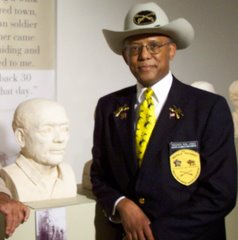
"E" Troop of the 11th Cavalry Regiment was stationed here in 1918 and since then therehave been a succession of home soldiers stationed at this strategic junction where road and rail road return to the United States after dipping into Baja California en route from San Diego to Yuma.
Ground was broken for the present camp on June 23rd 1941. The 11th Cavalry Regiment came there two days after the bombing of Pearl Harbor. Camp Lockett is a horse cavalry camp. The surrounding terrain offers unparalleled opportunities to test man, beast and mechanized carriers over a wide variety of terrain that includes heavily wooded underbrush, desert sand, miles of barren, rocky wastelands, Streams to be forded, and other geographic hazards identical to those which confront cavalry troopers in battle conditions.
Climatically this is a region of extremes. There is summer heat of 115 degrees; freezing temperature in winter. Long dry spells alternate with cloudbursts.
Some of the buildings were built as permanent cantonments while others were semi-permanent. The semi-permanent buildings no longer exist. There was a well equipped hospital which is now used as a youth facility. There are still standing many of the permanent barracks and some stables.
In 1942, the 10th Cavalry Regiment (the famed Buffalo Soldiers) moved into Camp Lockett to replace the11th Cavalry Regiment which had been converted into an armored unit. In 1943 The 28th Cavalry Regiment made up of inductees joined the 10th to form the 4th Cavalry Brigade of the 2nd Cavalry Division (Horse)
At the same time The 27th Cavalry Regiment, also made up of inductees, joined the 9th Cavalry Regiment to form the 5th Cavalry Brigade. This brigade was stationed in Fort Clark, Texas. Their duty was to guard the Texas-Mexican Border. While the 10th and 28th guarded the California-Mexican Border. These troopers also guarded the many installations along the border such as, trestles, bridges, dams, railroad tunnels and would be the first line of defense in case Germany or Japan attempted an invasion of the United States through Mexico.
In 1944 The 9th, 10th, 27th and 28th were dismounted and sent to North Africa. Soon after their arrival there all four regiments were inactivated and converted into service troops. This marked the end of the horse cavalry in the United States Army. The 28th, through an error was not officially inactivated until 1951.This makes Camp Lockett the last home of the last horse cavalry in the US Army.
Note: Information obtained from The California State Military Museum


No comments:
Post a Comment